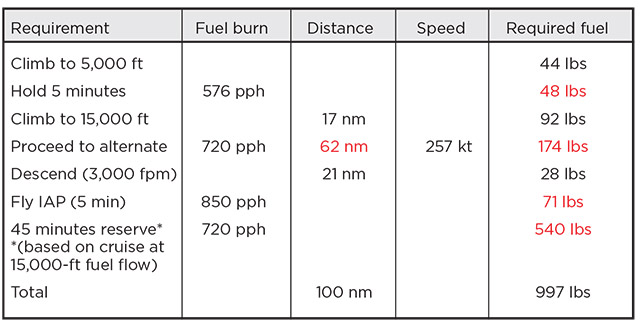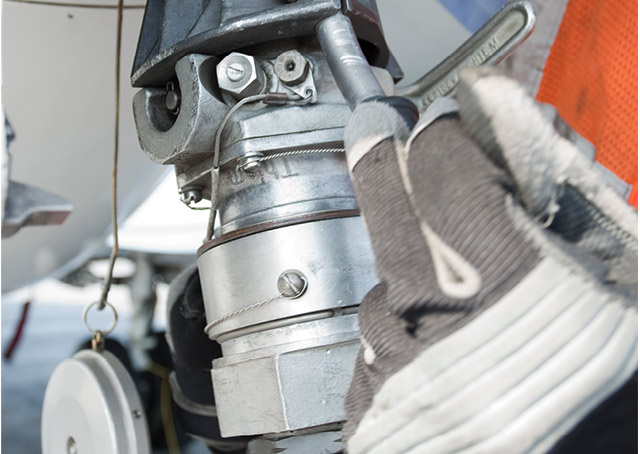Mentor Matters
Jets and fuel reserves
Weather isn’t the only reason an alternate might be needed
In contrast to piston aircraft, jets do not experience fuel-exhaustion accidents in large numbers. This can be attributed, at least in part, to the significantly more accurate fuel sensors found in the tanks of turbine aircraft. With accurate capacitance-type sensors feeding fuel quantity readings rather than historically unreliable float-type sensors, the pilot of a turboprop or jet has a very precise indication at all times of how much fuel remains in the tanks. Combining this information with equally precise fuel flow and groundspeed information, the avionics of current-production turbines can provide eerily precise estimates of remaining fuel reserves at a destination still hours away.

Above are actual performance numbers for a popular light jet. The figures in black were filled in directly from the pilot’s operating handbook climb, cruise, descent, and holding tables. The numbers in red were then calculated using the POH information.
Yet, despite the heightened accuracy and computing power available to turbine pilots, turboprops and jets do run out of fuel. When they do, it’s often attributable to excessively optimistic flight planning combined with insufficiently conservative fuel reserve planning. Consider the minimal requirements of the federal aviation regulations: The pilot of a light jet approaching an airport with forecast conditions at or above 2,000-foot ceilings and three statute miles visibility need only carry enough extra fuel to fly for 45 minutes at normal cruising speed. At what altitude that fuel burn should be planned is not specified in the FARs—yet covering the same mile of ground at sea level will take the aircraft more than twice the fuel it would at the aircraft’s ceiling.
Further, many pilots don’t adequately consider the non-weather reasons a last-minute diversion from the destination might be required. An aircraft running off the end of the only runway long enough for a jet; a retractable single landing gear-up at a single-runway airport; a police hostage situation causing a pop-up TFR to close an airport to landings—these are all situations I’ve experienced firsthand in just the past few years. None was weather related, yet all could require landing at an airport other than the destination if the airport closure coincides with arrival time.
Fortunately, all occurred in areas of dense airport population: In some parts of the country, it can be a long flight to the next sufficiently long runway if the destination unexpectedly closes. For this reason I strongly recommend pilots plan every flight, whether in VMC or instrument conditions, with the thought that the destination airport will become unavailable for landing at arrival time, and identify how far they would need to fly to locate a suitable alternate.
Decades ago, the National Business Aviation Association (NBAA) created a standardized method of calculating the real-world IFR range of turbine aircraft. While the “NBAA IFR range” metric was designed to facilitate an apples-to-apples comparison of different manufacturers’ offerings, it also turns out to be a useful tool in helping a pilot derive conservative fuel-reserve guidelines. Per the calculation, upon reaching the destination the pilot must have enough fuel to climb to 5,000 feet after a missed approach; hold for five minutes while determining where to divert and awaiting ATC clearance; climb to optimum cruise altitude and fly to the alternate at economy cruise; perform a 3,000-foot-per-minute descent; fly an instrument approach, and land with 30 minutes of fuel, based on low cruise power at 5,000 feet.
Using a conservative, 15,000-foot cruise altitude, and bumping the 30 minutes of landing fuel to 45 minutes to more closely align with the FARs, a pilot can fill in a worksheet using the manufacturer’s performance information, as shown in the table above. Some of the information is provided directly in the pilot’s operating handbook—e.g., the distance traveled and fuel burned in a climb to 15,000 feet. Other information must be calculated. For example, using the distance traveled in climb and descent, the pilot can calculate the remaining distance that will be flown in level cruise flight, and from there the time spent and fuel consumed in cruise.
In this example, the pilot would calculate that, to be able to proceed to an alternate 100 nautical miles from the destination, a reserve of 1,000 pounds of fuel would be adequate. The pilot could eliminate the 174 pounds used in cruise if he or she felt comfortable that the roughly 40 miles spent in climb to, and then immediate descent from, 15,000 feet would take the aircraft to a suitable alternate, for a “minimum” IFR reserve of just more than 800 pounds (approximately 120 gallons).
Neil Singer is a Master CFI with more than 8,500 hours in 15 years of flying.



